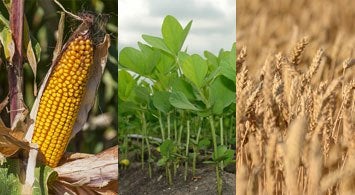
The practice of crop rotation has been practiced by farmers as far back as recorded hieroglyphics have shown. The Bible in Chapter 25 of Leviticus instructed the Israelites to keep a sabbath of the land by sowing for six years but letting the land go fallow in the seventh. Crop rotation, the practice of growing dissimilar crops in the same area in a planned sequence, can help minimize erosion, increase soil fertility and crop yield, and reduce reliance on chemical herbicides and fertilizers.
In early Europe, a two-field crop rotation had become popular. A two-field crop rotation would have half the field planted and half fallow with the two rotated each year. With half the acreage not producing any crop, clever minds in the late 8th century and early 9th sought to improve productivity which led to the three-field crop rotation. By the early 16th century, a four-field crop rotation had become popular. A four-field crop rotation would work in a sequence of something like wheat, turnips, barley, and clover with a fodder and grazing crop allowing livestock to be bred all year. The rotation between arable and ley is often referred to as ley farming.

In North America, and especially in the corn belt, agriculture is dominated by corn which has a high bushel yield for each acre grown and therefore a high return on investment. Nearly every farmer is aware of the benefits a crop rotation brings to the soil ecology, but a farm is a business and must produce a profit or go under. Some agribusinesses have gone as far to grow corn continuously, supplanting a healthy organic rotation cycle by relying on herbicides to control weed growth and fertilizers to counter depleted needed elements such as nitrogen and phosphorous. And though continuous corn can be successful, nuisances such as corn rootworm (CRW) which can destroy significant percentages of crop if left untreated are often associated. Soil-applied insecticides usually combat CRW well, but in areas of heavy insecticide usage, populations of CRW have been known to become resistant to certain insecticides.
Researchers at leading universities along with agricultural experts agree a crop rotation that takes into consideration variables such as market conditions, farm size, labor/equipment availability, climate, soil type, and growing practices, can be profitable while at the same time benefit soil ecology. Research shows multi-year, multi-crop rotations produce high yields for each crop in rotation, control pests and weeds with less reliance on chemicals, and enhance soil fertility with less need for synthetic fertilizers.

So where to start? A well-constructed crop rotation will take into consideration what conditions one grown crop leaves for another. Crops such as corn, tomatoes, lettuce and cabbage are nitrogen depleters. A successful rotation would follow a nitrogen depleter with a nitrogen fixing plant such as peas, beans or other legumes. And while peas, beans and other legumes add nitrogen, they need lots of phosphorus, so that content needs to be watched and cared for. Perhaps a new adage needs to proliferate, that of paying as much attention to the rotated crop as the mainstay which typically is corn. That means doing things such as selecting a seed that has the best genetics, moving to narrower rows if the rotating crop is soybean (google Kitchen Sink Soybean Study), fertilizing and applying preemergent herbicides as needed, and controlling volunteer corn early on.

If the mainstay crop is cotton, which is a soil-depleting crop, the rotation would be a soil-enriching crop such as peanuts or peas. Wheat is gaining in popularity as a rotation crop, especially in farms running a traditional corn-soybean rotation. By adding wheat as a third crop, research has shown a number of beneficial plusses. Those plusses include aiding in the management of glyphosate-resistant weeds and pests such as the soybean cyst nematode. CRW which in the past has been controlled by a rotation to soybean for a year has been known to anticipate the soybean rotation and go dormant for that year only to return when the corn crop returns to the rotation. That additional year of adding wheat to the rotation breaks that anticipation and starves the emerging rootworms. In a corn-soy-wheat rotation, it’s best to have the wheat follow the soy due to the Fusarium ear blight (FEB) that overwinters on stalks of wheat and corn. Because wheat is susceptible and corn isn’t, it’s better to grow wheat after soybeans.

Crop Rotation Pros
• Natural replacement of soil nutrients depleted by a single crop
• Improved crop yields
• Reduction in pest populations
• Improved weed control
• Less reliance on chemical pesticides
• Reduced need for synthetic fertilizers
Crop Rotation Minuses
• Need to carefully consider the unique variables and conditions
• Requires more knowledge and skills
• Requires more time preparing for the rotations
• May require additional equipment and their associated cost
• Need to treat the rotation crop as carefully as the mainstay
• May have lesser financial returns at certain times
• It may not be favorable in certain growing conditions

Crop rotation should be thought of as a methodology to a more healthy, sustainable food system; where a variety of crops are grown with improved yields, reduced pests and weeds, and less reliance on chemicals and fertilizers.
 Your Privacy Choices
Your Privacy Choices